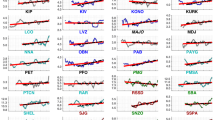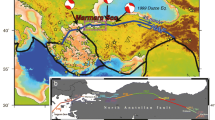Abstract
Before seismological catalogs were routinely produced, seafarers experienced major seismic events at sea that were documented in their logs. This article analyzes some of these old records—mostly from eighteenth and nineteenth centuries—in the context of plate tectonics. Large shocks that were felt on ships are related either to earthquakes, sub-marine volcanic eruptions, or to sub-marine sliding of rocks and/or sediments. We analyze various related parameters such as the location and size of the shaking, the duration of the shock, and the associated noise. A total of 396 observations have been retained for this study, mostly located in the Atlantic Ocean, reflecting its intense maritime traffic during the period of interest. Some of the detailed accounts allow us to clearly identify the nature of the shocks, including a possible interpretation in terms of focal mechanism. Our results, when compared to historical catalogs, reveal many previously undetected large events. Macroseismic results for a few large historical events occurring near the coasts confirm the validity of our approach, but also reveal its limitations. The good locations of most of the events allow us to relate them to plate boundaries. The Romanche transform zone has deserved particular interest due to the large number of related testimonies. This study particularly illustrates that historical seismicity may be applied to oceans. The collected testimonies also show how impressive and dangerous these large earthquakes at sea are, despite the absence of S-waves.




Similar content being viewed by others
References
Abercrombie RE, Ekström G (2001) Earthquake slip on oceanic transform faults. Nature 410:74–77
Bakun WH, Hopper MG (2004) Magnitudes and locations of the 1811-1812 New Madrid, Missouri, and the 1886 Charleston, South Carolina, earthquakes. Bull Seismol Soc Am 94:64–75
Baptista MA, Miranda PMA, Miranda JM, Mendès Victor L (1998) Constraints on the source of the 1755 Lisbon tsunami inferred from numerical modelling of historical data. J Geodyn 25:159–174
Barry JM (1866) On submarine earthquakes and volcanoes. Dublin Quart. J. Sci VI, 199 pp
Bergman EA, Solomon SE (1985) Earthquake source mechanisms from body-waveform inversion and intraplate tectonics in the northern Indian Ocean. Phys Earth Planet Inter 40:1–23
Bertrand A (1839) Lettres sur les Révolutions du Globe, cinquième édition. Just Tessier Libraire-Editeur, Paris, 501pp
Bonatti E, Ligi M, Gasperini L, Peyve A, Raznitsin Y, Chen YJ (1994) Transform migration and vertical tectonics at the Romanche fracture zone, equatorial Atlantic. J Geophys Res 99:21779–21802
Bonatti E, Ligi M, Carrara G, Gasperini L, Turko N, Perfiliev S, Peyve A, Sciuto PF (1996) Diffuse impact of the Mid-Atlantic Ridge with the Romanche transform: an ultracold ridge transform intersection. J Geophys Res 101:8043–8054
Cande SC, LaBrecque JL, Haxby WF (1988) Plate Kinematics of the South Atlantic chron C34 to the present. J Geophys Res 93:13479–13492
Choy JE, Palme C, Guada C, Morandi M, Klarica S (2010) Macroseismic interpretation of the 1812 earthquakes in Venezuela using intensity uncertainties and a priori fault-strike information. Bull Seismol Soc Am 100:241–255
Comte D, Pardo M (1991) Reappraisal of great historical earthquakes in the Northern Chile and Southern Peru seismic gaps. Nat Hazards 4:23–44
Darby DJ, Beanland S (1992) Possible source models for the 1855 Wairarapa earthquake, New Zealand. J Geophys Res 97:12375–12389
Daussy M (1838) Note sur l’existence probable d’un volcan sous-marin situé par environ 0°20’ de latitude sud, et 22° de longitude ouest. C. R. Acad. Sci. Paris V: 512–516
Daussy M (1842) Notes. C.R. Acad. Sci. Paris XV: 446
de Rossi MS (1883) Programma del l'osservatorio ed archivio centrale geodinamico presso il R. Comitato Geologico d'Italia. Bullettino Vulcanismo Italiano 10:3–128
Ekström G, Nettles M, Dziewonski AM (2012) The global CMT project 2004–2010: centroid-moment tensors for 13,017 earthquakes. Phys Earth Planet Inter 200–201:1–9
Feuillet N, Beauducel F, Tapponnier P (2011) Tectonic context of moderate to large historical earthquakes in the Lesser Antilles and mechanical coupling with volcanoes. J Geophys Res 116:B10308
Fisher FH, Simmons VP (1977) Sound absorption in sea water. J Acoust Soc Am 62:558–564
Honnorez J, Mascle J, Basile C, Tricart P, Villeneuve M, Bertrand H (1991) Mapping a segment of the Romanche Fracture Zone : a morphostructural analysis of a major transform fault of the equatorial Atlantic Ocean. Geology 19:795–798
Hough SE (2013) Missing great earthquakes. J Geophys Res 118:1098–1108
Hough SE, Munsey J, Ward SN (2013) Reverberation on watery element: a significant, tsunamigenic historical earthquake offshore the Carolina coast. Seismol Res Lett 84:891–898
Johnston AC (1996) Seismic moment assessment of earthquakes in stable continental regions –III. New Madrid 1811-1812, Charleston 1886 and Lisbon 1755. Geophys J Int 126:314–344
Kanamori H, Stewart GS (1976) Mode of strain release along the Gibbs fracture zone Mid-Atlantic ridge. Phys Earth Planet Inter 11:312–335
Kanamori H, Stewart GS (1979) A slow earthquake. Phys Earth Planet Inter 18:167–175
Lomax A, Michelini A (2009) Mwpd: a duration-amplitude procedure for rapid determination of earthquake magnitude and tsunamigenic potential from P waveforms. Geophys J Int 176:200–214
Mallet R (1858) On the facts and theory of earthquake phenomena. Report of the British Association for the Advancement of Science, London
Martin S, Szeliga W (2010) A catalog of felt intensity data for 570 earthquakes in India from 1636 to 2009. Bull Seismol Soc Am 100:562–569
McGuire JJ, Ihmlé PF, Jordan TH (1996) Time domain observations of a slow precursor to the 1994 Romanche transform earthquake. Science 274:82–86
Montessus de Ballore F (1907) Géographie sismologique (Les tremblements de Terre). Armand Colin, Paris, 475 pp
Montessus de Ballore F (1908) La science sismologique (Les tremblements de Terre). Armand Colin, Paris, 590 pp
Montessus de Ballore F (1911) La sismologie moderne (Les tremblements de Terre). Armand Colin, Paris, 284 pp
Okal EA (2001) T-phase stations for the International Monitoring System of the Comprehensive Nuclear-Test Ban Treaty: a global perspective. Seismol Res Lett 72:186–196
Okal EA (2003) T waves from the 1998 Papua New Guinea earthquake and its afterschocks. Pure Appl Geophys 160:1843–1863
Perrey A (1847) Documents sur les tremblements de terre et les éruptions volcaniques dans le bassin de l'Océan Atlantique. Mémoires de l'Académie de Dijon, partie des Sciences, S.1
Roth J (1882) Über die Erbeben. Karl Habel Verlag, Berlin
Rudolph E (1887a) Ueber submarine Erdbeben und Eruptionnen. Inaugural dissertation, Wilhelms-Universität Strassburg, Beiträge zur Geophysik, E. Schweizerbart'sche Verlagsbuchhandlung (E. Koch), ed., Stuttgart, 94 pp
Rudolph E (1887b) Ueber submarine Erdbeben und eruptionen mit Anhang: Verzeichniss des submarinen Erdbeben. Beitr Geophys 1:133–365
Rudolph E (1895) Ueber submarine Erdbeben und Eruptionen; Zweites Verzeichniss des Seebeben. Beitr. zur Geophysik II: 542–598
Rudolph E (1898) Ueber submarine Erdbeben und eruptionen. Beitr. zur Geophysik, III, 273 pp.
Sieberg AH (1904) Handbuch der Erdebebenkunde, F.Viehweg und Sohn ed., Braunschweig, 362 pp
Sykes LR (1978) Intraplate seismicity, reactivation of preexisting zones of weakness, alkaline magmatism, and other tectonism postdating continental fragmentation. Rev Geophys 16(4):621–688
Szeliga W, Hough S, Martin S, Bilham R (2010) Intensity, magnitude, location and attenuation in India for felt earthquakes since 1762. Bull Seismol Soc Am 100:570–584
Talandier J, Okal EA (1979) Human perception of T waves: the June 22, 1977 Tonga earthquake felt on Tahiti. Bull Seismol Soc Am 69:1475–1486
ten Brink US, Bakun WH, Flores CH (2011) Historical perspective on seismic hazard to Hispaniola and the northeast Caribbean region. J Geophys Res 116:B12318
Wegener A (1915) Die Entstehung der Kontinente and Ozeane (first edition). Friedrich Vieweg & Sohn, Braunschweig
Wessel P, Smith WHF (1991) Free software helps map and display data. EOS Trans Am Geophys Union 72:441–446
Acknowledgments
We benefited from the help of the staff in charge of the Archives in many institutions, the following in particular: the KIT-Bibliothek, Karlsruhe, the Bibliothèque of Lille, the Bibliothèque Nationale de France, the Bibliothèque of the Académie des Sciences, Paris, the Centre Technique du Livre de l'Enseignement Supérieur, the Service Historique de la Marine, Paris, and the Stuttgart University Library. We thank Mrs Magali Pierrat from EOST for gathering copies of original works from various institutions, and Mrs Suzanne and Clémence Meyer for their precious help to translate and interpret Rudolph’s publications. The authors also thank their colleagues for helpful discussions. Many thanks to Susan Hough for her clever and informative review and for the documents she made available to us, and to the Editor in Chief Mariano Garcia-Fernandez. Figures have been drawn with the GMT software (Wessel and Smith 1991).
Conflict of interest
The authors declare that they have no competing interests.
Author information
Authors and Affiliations
Corresponding author
Rights and permissions
About this article
Cite this article
Rouland, D., Legrand, D., Cisternas, A. et al. Historical seismicity in oceans from sailors’ testimonies. J Seismol 20, 251–264 (2016). https://doi.org/10.1007/s10950-015-9523-y
Received:
Accepted:
Published:
Issue Date:
DOI: https://doi.org/10.1007/s10950-015-9523-y




